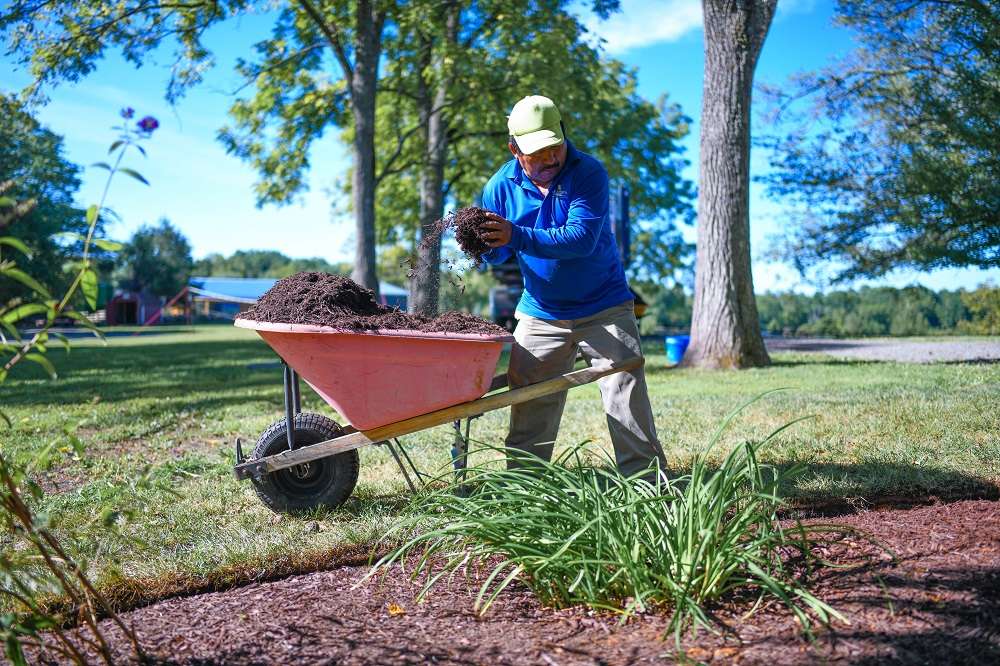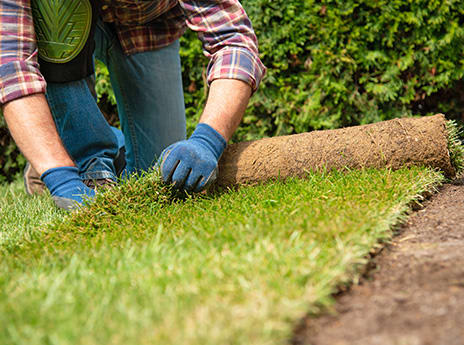Recognizing the Comprehensive Scope of Functions in Expert Landscaping Services
The considerable range of expert landscape design services encompasses a selection of basic elements. It consists of landscape design concepts, plant option, and hardscaping functions. In addition, it deals with irrigation systems and maintenance techniques. Each facet plays a vital function in producing practical and cosmetically pleasing outdoor areas. Comprehending just how these parts collaborate can expose much regarding the art and science of landscape design. The trip right into this detailed area is just starting.
Landscape Design Concepts
Efficient landscape layout concepts are crucial for producing unified outside areas that improve both aesthetic appeal and functionality. These principles lead the setup of elements within the landscape, guaranteeing a cohesive visual experience. Secret elements include equilibrium, which distributes aesthetic weight equally; percentage, which relates the size of different elements per various other and the space; and unity, which develops a sense of wholeness through regular styles and products.
Emphasis directs interest to focal points, while rhythm establishes motion with repetition of design functions. The effective usage of line can develop paths and lead the eye through the landscape. Additionally, comprehending the website's topography, climate, and existing functions is essential for assimilation with the surrounding environment. By adhering to these fundamental concepts, landscape designers can craft areas that not just look enticing however likewise offer their desired objective, boosting the total experience for individuals.
Plant Selection and Setup
In the domain name of expert landscape design, plant selection and setup play a vital role in achieving a thriving garden - landscaping services. Stressing native plant benefits, seasonal considerations, and the particular soil and sunshine requirements of each varieties assures a lasting and visually pleasing landscape. Careful planning in these areas not only improves biodiversity yet likewise promotes long-lasting ecological wellness
Native Plant Advantages
Why should homeowners consider native plants for their landscaping tasks? Native plants offer numerous benefits that enhance both visual appeals and environmental sustainability. They are well-adapted to local environments, calling for less water and maintenance compared to non-native varieties. This resilience reduces the need for chemical plant foods and chemicals, promoting a much healthier ecosystem. Additionally, native plants provide environment and food for neighborhood wildlife, consisting of pollinators, which can increase biodiversity in domestic areas. Their familiarity with regional dirt and weather condition problems also results in far better development prices and long life. By picking native plants, house owners not only produce visually appealing landscapes yet additionally add to environmental preservation, making a favorable influence on their regional setting. Indigenous plants represent a clever selection for landscape design projects.
Seasonal Plant Considerations
House owners who have actually accepted indigenous plants in their landscaping can additionally enhance their exterior areas by taking into consideration seasonal plant choices. By incorporating plants that thrive in details periods, they can produce dynamic and visually attractive landscapes throughout the year. Spring may usher in vibrant blossoms like tulips and daffodils, while summertime can showcase lush vegetation and vibrant perennials. Fall introduces a scheme of warm tones with asters and goldenrods, while winter months can be highlighted with evergreens and decorative yards for appearance. Professional landscaping companies typically advise selecting plants that not only complement existing indigenous species but likewise give year-round passion and support local wild animals. This thoughtful approach to seasonal plant selection ensures a continuously advancing and lasting yard setting.
Dirt and Sunlight Needs
Successful landscape design depends upon recognizing the specific soil and sunshine requirements of plants. Different varieties prosper under differing conditions, requiring a cautious assessment of both factors during the choice process (landscaping services). Dirt types, such as sandy, clay, or fertile, impact water drainage, nutrient availability, and root growth. Additionally, pH degrees can influence plant wellness, demanding dirt screening to identify viability. Sunshine needs differ significantly; some plants grow in full sunlight, while others favor full or partial color. An expert landscaper takes into consideration these elements to assure peak development and visual allure. By aligning plant choices with the setting's certain characteristics, landscapes can accomplish sustainability, durability, and visual harmony, inevitably causing successful plant establishment and long-lasting maintenance
Hardscaping Functions and Construction
While landscape design typically evokes photos of lavish plant and dynamic flowers, hardscaping functions play a crucial duty in defining outside spaces. These components, which include patio areas, pathways, keeping wall surfaces, and decorative stonework, offer framework and functionality to yards and yards. Hardscaping utilizes products such as concrete, stone, block, and wood, permitting diverse styles that enhance the all-natural landscape.
The construction of hardscaping functions requires mindful preparation and implementation to guarantee longevity and visual allure. Experts analyze site problems, water drainage, and spatial connections to produce cohesive outdoor settings. Correct setup strategies are critical, as they prevent issues like disintegration and shifting gradually.
Including hardscaping not only boosts the aesthetic rate of interest of a building however also assists in exterior activities, making it a fundamental element of comprehensive landscaping services. Eventually, thoughtful hardscaping contributes to both the capability and charm of outdoor spaces.
Watering Equipments and Water Management
Effective irrigation systems and water monitoring are crucial parts of professional landscape design, as they assure that plants receive the essential hydration for suitable development. These systems can vary from simple drip irrigation arrangements to advanced automated lawn sprinkler systems, developed to meet the particular demands of varied landscapes. Correct water management not just maximizes water use, minimizing waste, however also enhances plant wellness and minimizes illness dangers.
Landscape design specialists examine different factors, including dirt kind, plant species, and neighborhood climate, to establish customized irrigation solutions. Furthermore, including rainwater harvesting methods can better enhance sustainability and efficiency (Contact Ignite Landscapes). Regular maintenance of irrigation systems is necessary to keep capability and stop leakages, which can cause water loss and raised costs. Eventually, a well-designed irrigation system plays a critical duty in preserving the aesthetic charm of outside areas while advertising ecological stewardship within specialist landscaping techniques
Lawn Treatment and Upkeep Strategies
Grass treatment and maintenance methods are basic for achieving a lavish, healthy and balanced lawn that improves the total landscape. These strategies encompass various practices focused on advertising ideal development and visual appeal. Regular mowing is necessary, as it encourages thick, even development while protecting against weeds from establishing. Additionally, correct fertilizing provides essential nutrients, with applications tailored to the details yard type and dirt problems.
Watering methods must concentrate on deep, infrequent watering to motivate origin development, while aeration improves dirt structure and advertises nutrition absorption. Bug and condition management is likewise important; recognizing concerns early permits reliable therapies that minimize damages.
Overseeding can rejuvenate slim or damaged grass, boosting density and color. By carrying out these targeted yard treatment approaches, landscaping specialists can ensure that lawns remain vibrant and healthy and balanced throughout the seasons, greatly contributing to the total charm of the property
Seasonal Landscape Care and Maintenance
As the periods adjustment, correct landscape care becomes important for keeping the wellness and beauty of outdoor spaces. Each period provides distinct obstacles and demands. In spring, landscape professionals focus on trimming, planting, and fertilizing to encourage development. Summer demands regular watering, weed control, and pest monitoring to protect newly developed plants.
Fall needs the preparation of gardens for wintertime, including mulching, leaf removal, and the growing of bulbs for the following spring. In addition, wintertime care involves securing at risk plants from frost and guaranteeing that hardscapes are risk-free and useful.
Throughout the year, seasonal landscape maintenance assurances that outside locations stay healthy and balanced and aesthetically enticing. Expert services can provide customized maintenance strategies that adapt to the certain needs of each season, allowing residential or commercial property proprietors to delight in dynamic landscapes year-round. On the whole, seasonal treatment is an essential facet of professional landscaping that advertises long life and aesthetic value.
Lasting Landscape Design Practices
A growing variety of homeowner are welcoming lasting landscaping methods to create eco-friendly outdoor areas. These methods focus on preserving resources, enhancing biodiversity, and reducing environmental influence. Indigenous plants are frequently chosen for their reduced water needs and compatibility with neighborhood ecological communities, decreasing the need for chemical fertilizers and pesticides. Rainfall yards and absorptive paving are used to take care of stormwater overflow, promoting groundwater recharge and minimizing erosion.
Sustainable landscaping incorporates natural horticulture methods that focus on soil wellness and promote natural pest control. Efficient irrigation systems, such as drip watering and rainwater harvesting, help maximize water usage. Additionally, landscape designers significantly support for making use of recycled materials, such as recovered timber and rocks, to lessen waste. By embracing these sustainable practices, homeowner not just add to environmental conservation yet also produce visually pleasing atmospheres that can love marginal upkeep.
Often Asked Inquiries
How much time Does a Landscaping Task Typically Take to Total?
Normally, a landscaping project can take anywhere from a few days to numerous weeks to finish, depending on the project's complexity, size, and style demands. Read More. Elements such as climate and source schedule also affect timelines
What Variables Impact the Price of Landscape Design Services?
Numerous aspects influence landscaping solution expenses, consisting of job size, style complexity, worldly high quality, labor expenditures, geographical place, and seasonal demand. Each component contributes uniquely to the general financial demands of a landscaping project.
Are Landscaping Provider Available Year-Round?
Landscaping services are typically available year-round, although schedule may differ based on area, seasonal weather, and specific solution offerings. Some services may be limited throughout extreme weather condition or off-peak seasons.
Do Landscaping Companies Deal Guarantees on Their Job?

Can I Style My Landscape Without Specialist Help?
Yes, people can design their landscapes without expert aid. Nonetheless, they may lack experience in plant option, format, and ecological factors to consider, possibly bring about much less reliable styles that might require costly adjustments later on.
